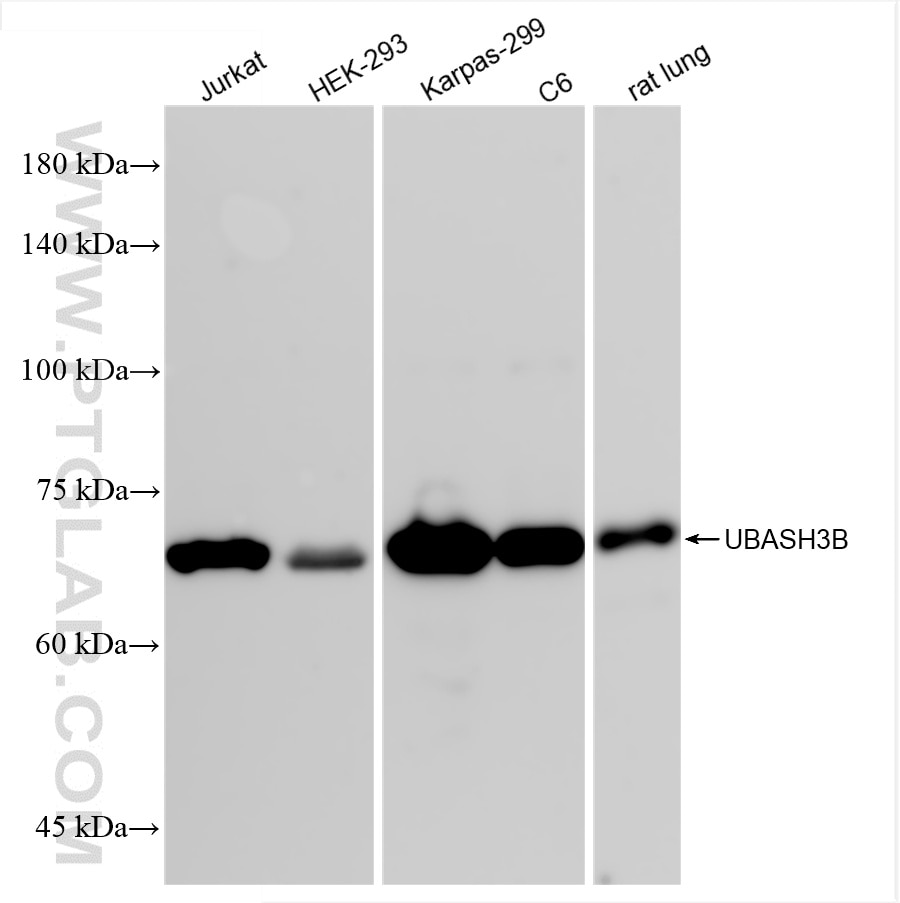UBASH3B Rekombinanter Antikörper
UBASH3B Rekombinant Antikörper für WB, ELISA
Wirt / Isotyp
Kaninchen / IgG
Getestete Reaktivität
human, Ratte
Anwendung
WB, ELISA
Konjugation
Unkonjugiert
CloneNo.
250256G12
Kat-Nr. : 85904-1-RR
Synonyme
Geprüfte Anwendungen
| Erfolgreiche Detektion in WB | Jurkat-Zellen, C6-Zellen, HEK-293-Zellen, Rattenlungengewebe |
Empfohlene Verdünnung
| Anwendung | Verdünnung |
|---|---|
| Western Blot (WB) | WB : 1:5000-1:50000 |
| It is recommended that this reagent should be titrated in each testing system to obtain optimal results. | |
| Sample-dependent, check data in validation data gallery | |
Produktinformation
85904-1-RR bindet in WB, ELISA UBASH3B und zeigt Reaktivität mit human, Ratten
| Getestete Reaktivität | human, Ratte |
| Wirt / Isotyp | Kaninchen / IgG |
| Klonalität | Rekombinant |
| Typ | Antikörper |
| Immunogen | Peptid |
| Vollständiger Name | ubiquitin associated and SH3 domain containing, B |
| Berechnetes Molekulargewicht | 73 kDa |
| Beobachtetes Molekulargewicht | 66-70 kDa |
| GenBank-Zugangsnummer | NM_032873 |
| Gene symbol | UBASH3B |
| Gene ID (NCBI) | 84959 |
| Konjugation | Unkonjugiert |
| Form | Liquid |
| Reinigungsmethode | Protein-A-Reinigung |
| Lagerungspuffer | PBS with 0.02% sodium azide and 50% glycerol |
| Lagerungsbedingungen | Bei -20°C lagern. Nach dem Versand ein Jahr lang stabil Aliquotieren ist bei -20oC Lagerung nicht notwendig. 20ul Größen enthalten 0,1% BSA. |
Hintergrundinformationen
UBASH3B, also named STS1 or TULA-2, is a protein that contains a ubiquitin-associated domain at the N-terminus, a SH3 domain, and a C-terminal domain with similarities to the catalytic motif of phosphoglycerate mutase. TULA-2 is supposed to form homodimer and interact with ubiquitin and mono-ubiquitinated proteins. TULA-2 functions to promote accumulation of activated target receptors, such as T-cell receptors and EGFR on the cell surface.
Protokolle
| PRODUKTSPEZIFISCHE PROTOKOLLE | |
|---|---|
| WB protocol for UBASH3B antibody 85904-1-RR | Protokoll herunterladen |
| STANDARD-PROTOKOLLE | |
|---|---|
| Klicken Sie hier, um unsere Standardprotokolle anzuzeigen |


